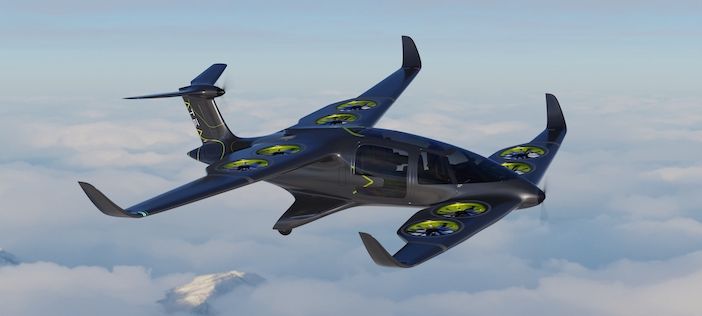Toulouse, France-based VTOL aircraft developer Ascendance Flight Technologies has revealed an updated design of its Atea air taxi featuring a tandem wing configuration with rotors built into them.
Atea is a hybrid electric 5-seater vertical take-off and landing (VTOL) aircraft with a range of 400km (250 miles). The aircraft is designed for so-called “Lift + Cruise” flight and uses two separate propulsion systems for vertical and horizontal flight: 8 rotors integrated into two fixed wings and 2 horizontal propellers.
The startup, which was founded three years ago, is developing the hybrid-electric powertrain and its “fan-in-wing” technology in house.
According to Ascendance, the patented shrouded rotor technology it is using in the wings allows for increased power during the take-off and landing phases and significant noise reduction. The number of rotors guarantees the manoeuvrability of the aircraft in case of failure, with resilience being compliant with regulatory requirements.
Propellers located in the nose and tailfin are used for horizontal flight. The absence of pivoting mechanisms reduces the risk of failure and simplifies the aircraft’s certification while improving overall aircraft safety, said the company.
The modular-hybrid powertrain being developed is called Sterna. The company plans to eventually phase out the combustion energy source and replace it with new sources of cleaner energy such as hydrogen or Sustainable Aviation Fuel.
Engineers at Ascendance are currently working on a full scale prototype. The company plans to enter the flight testing phase of development in 2023.
The company plans to publicly demonstrate the aircraft first at the Paris Olympics in 2024 and for serial production to begin in 2025.
Jean-Christophe Lambert, co-founder and CEO (video above) said, “The design of Atea is a concrete reflection of our values, our experience and of our know-how. It is the result of a huge effort by our R&D department, tests and trials on four prototypes and a great deal of thought on costs and the ease of flying such an aircraft.
“Its characteristics provide all the performances expected by a sector that the ongoing transition has made more demanding.”

“With help from our financial partners we are now experiencing vigorous development. We are actively recruiting, running test and trial programs and we are steadily moving towards our 2025 certification objective,” Lambert added.




